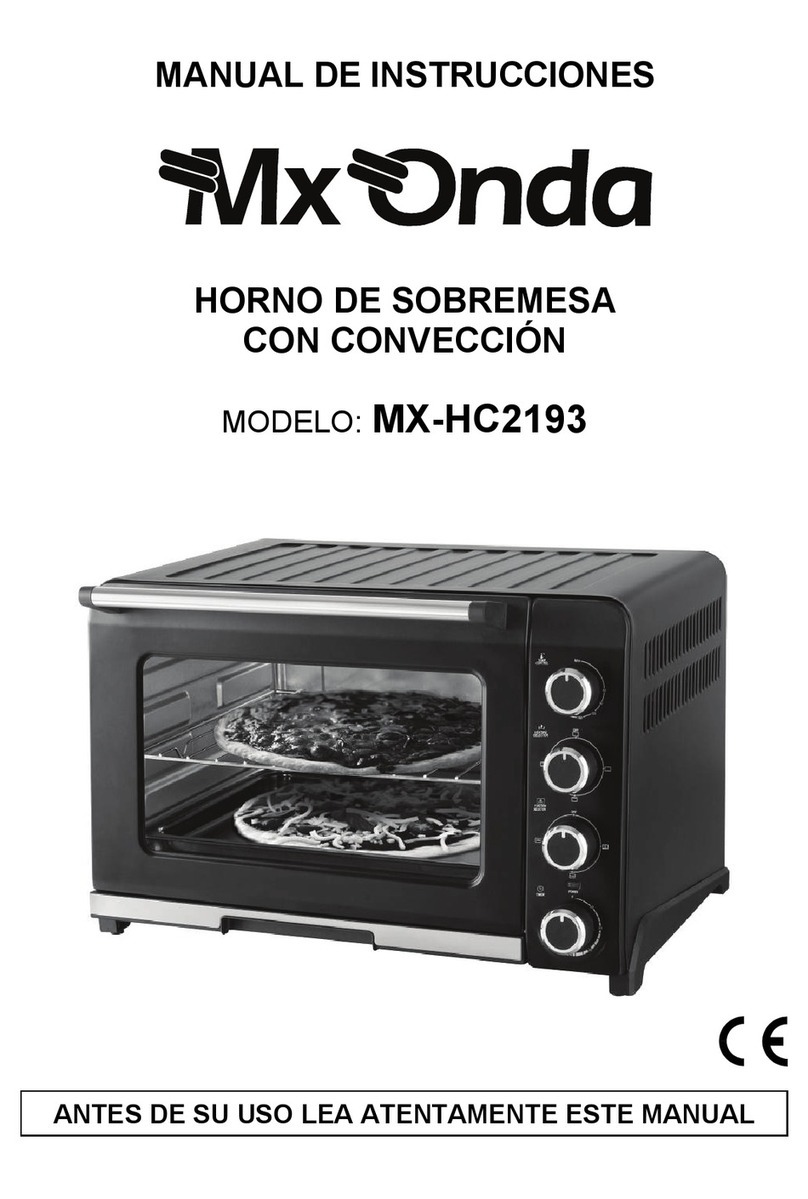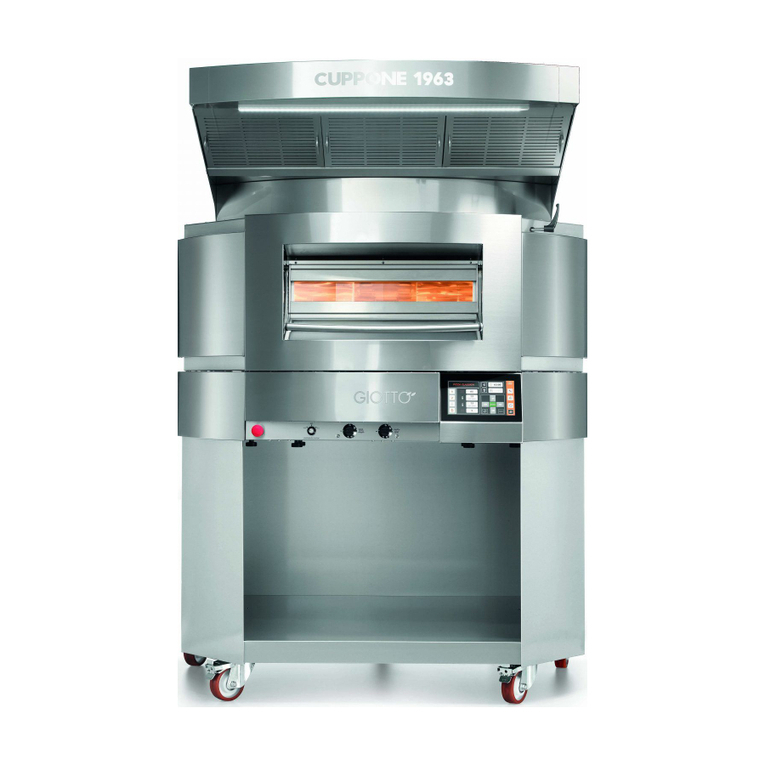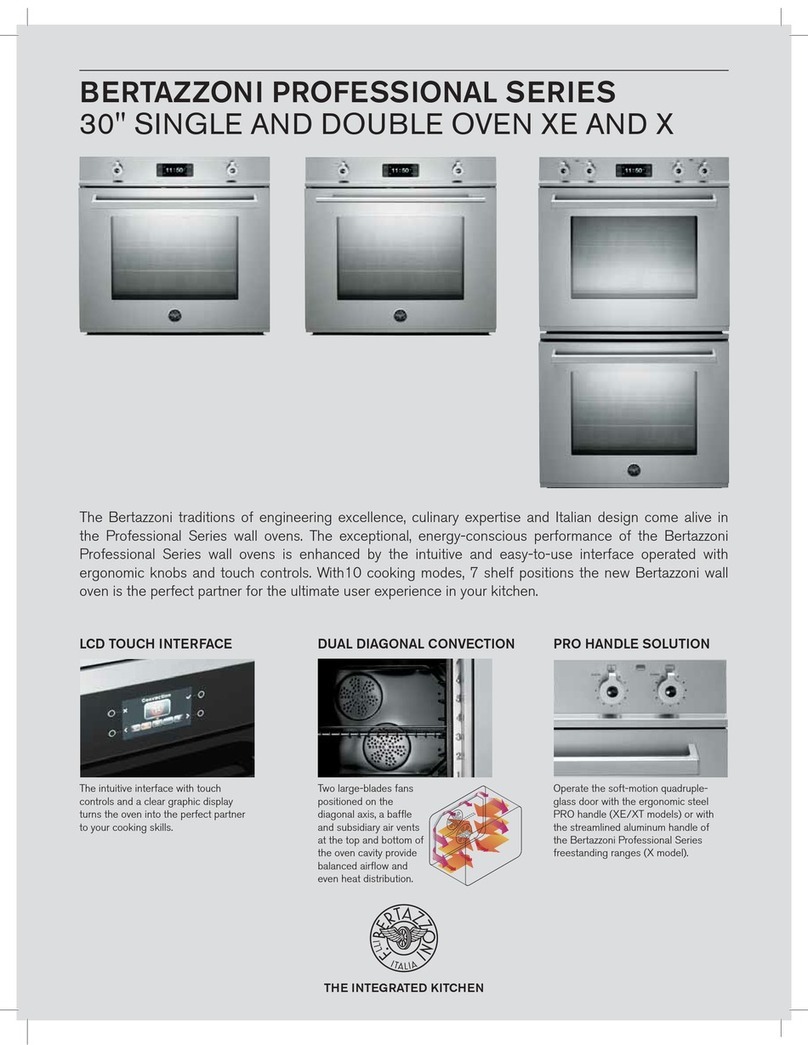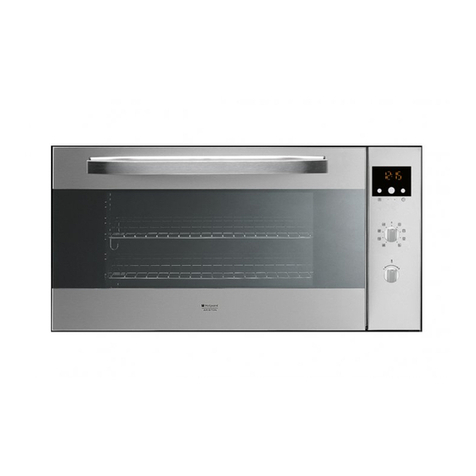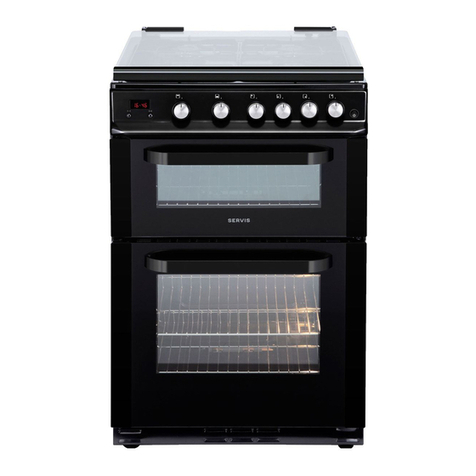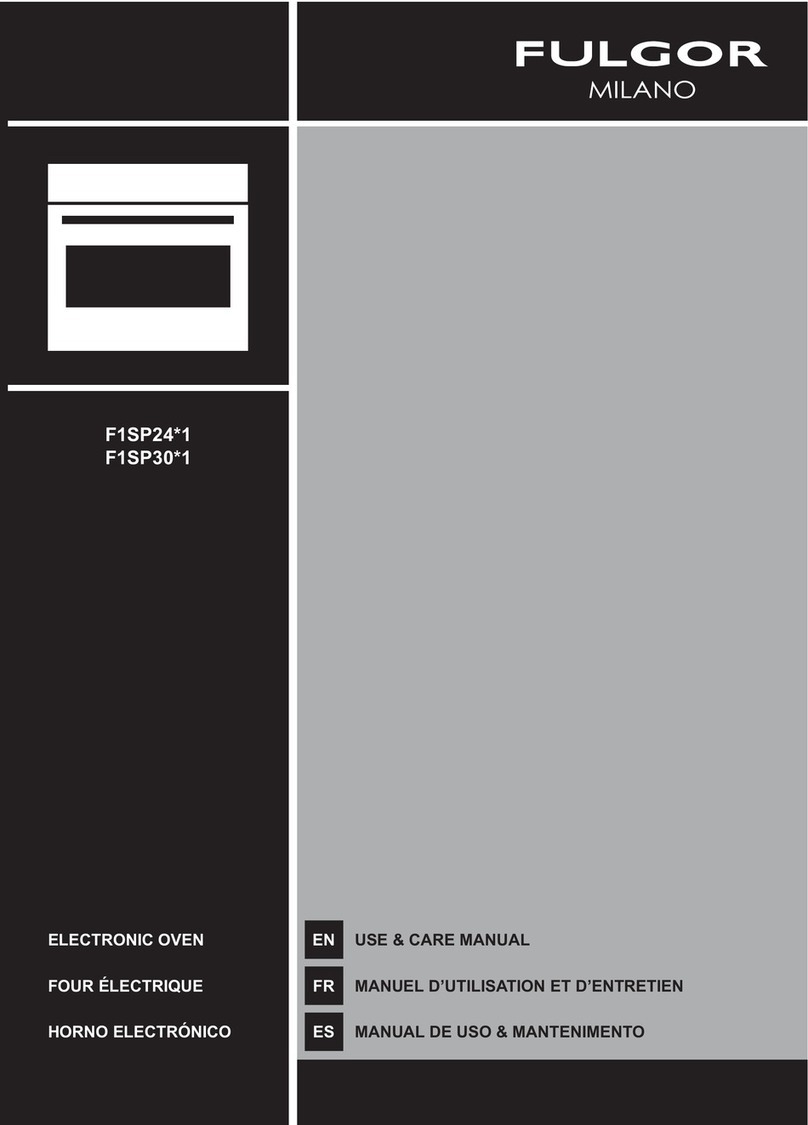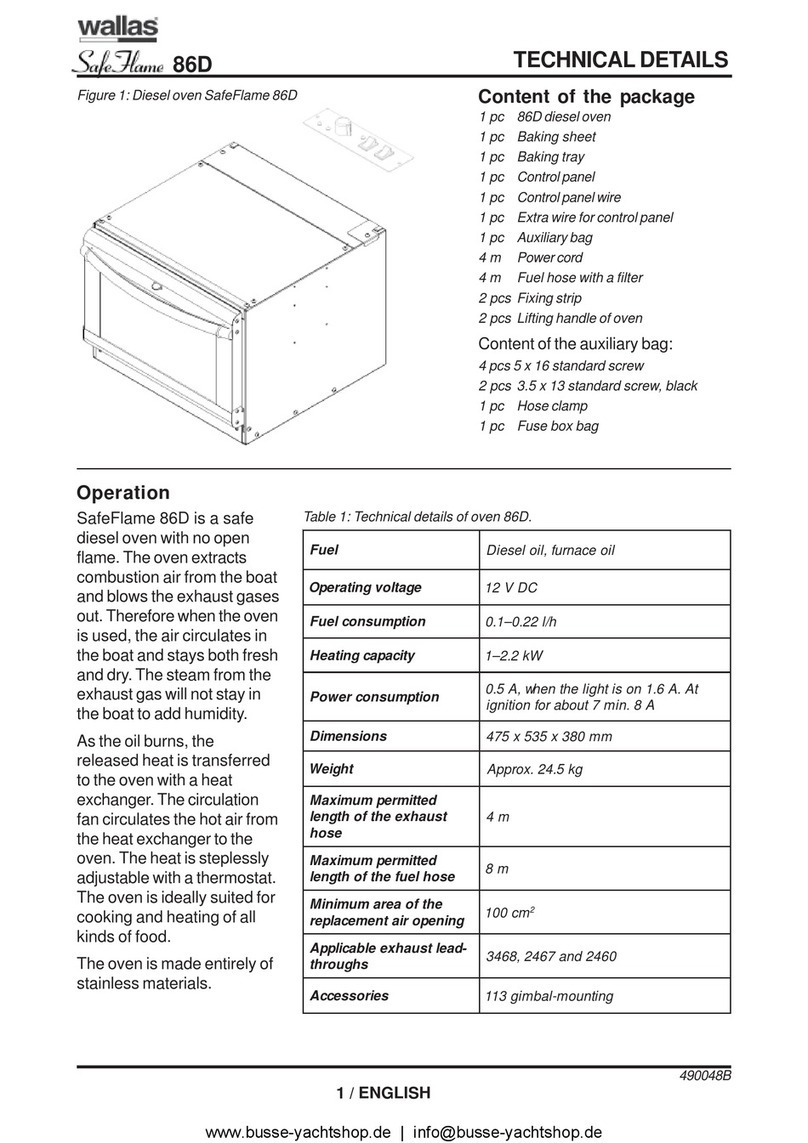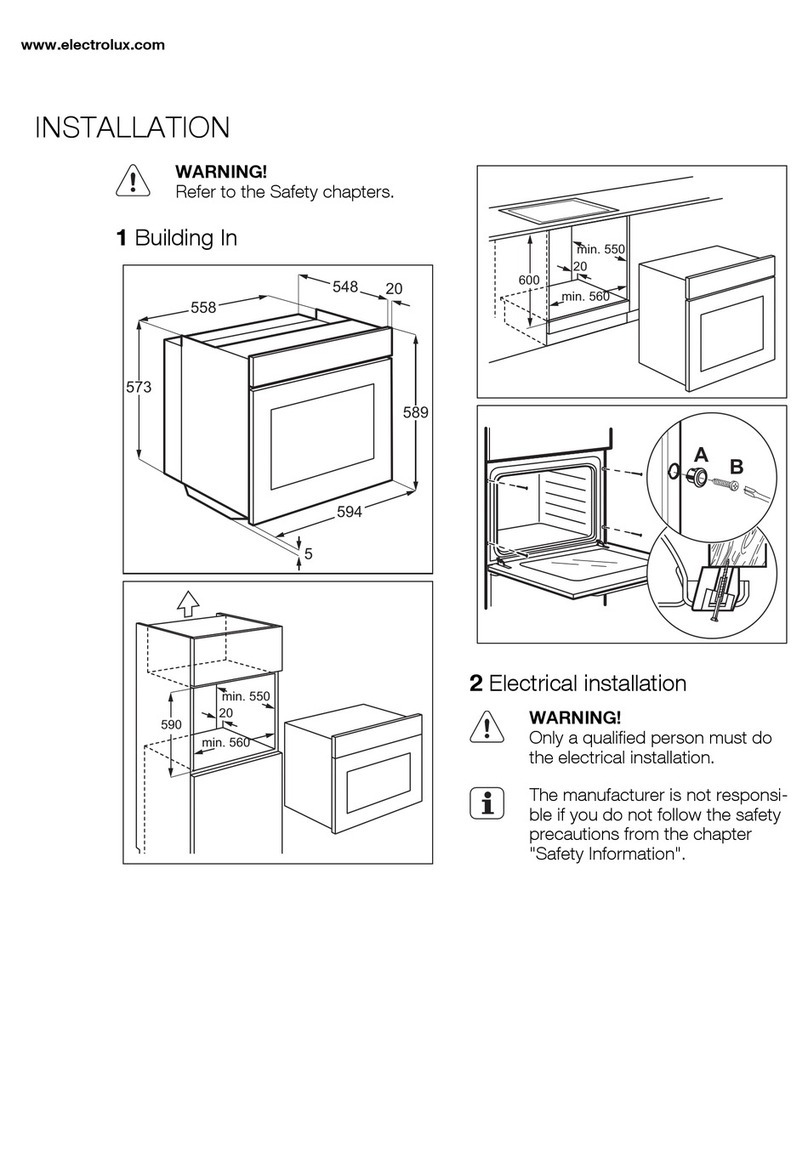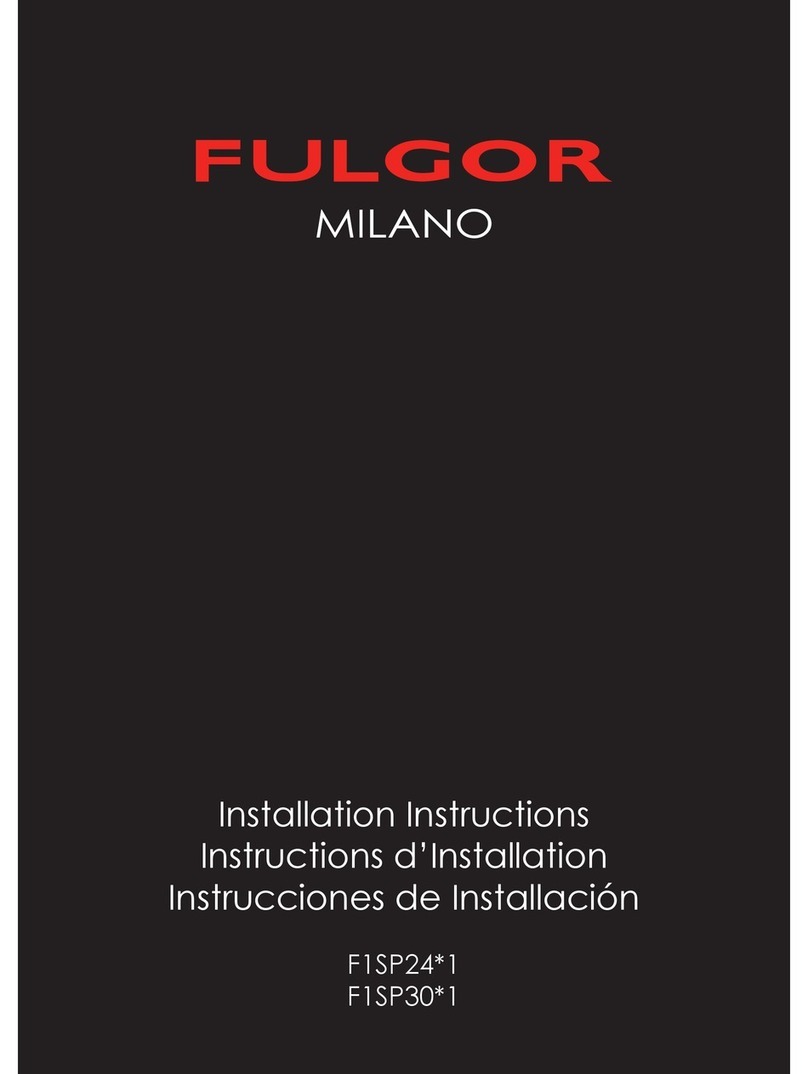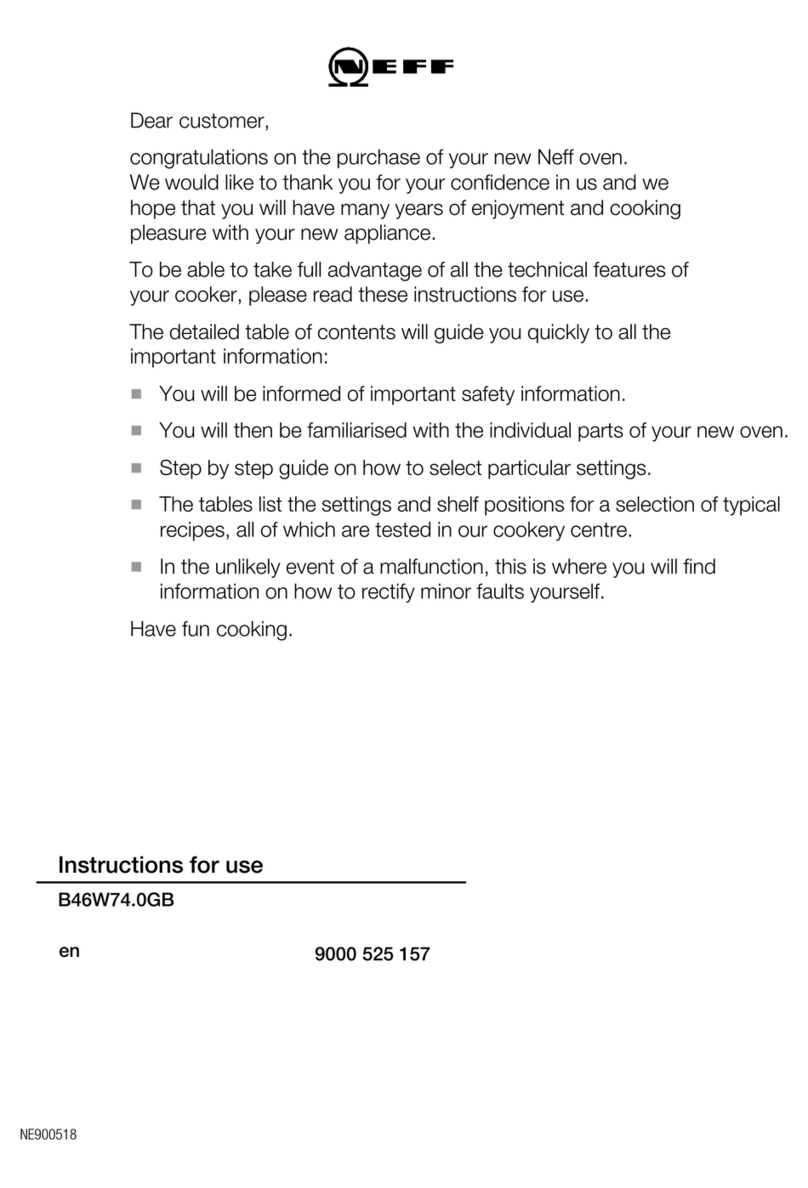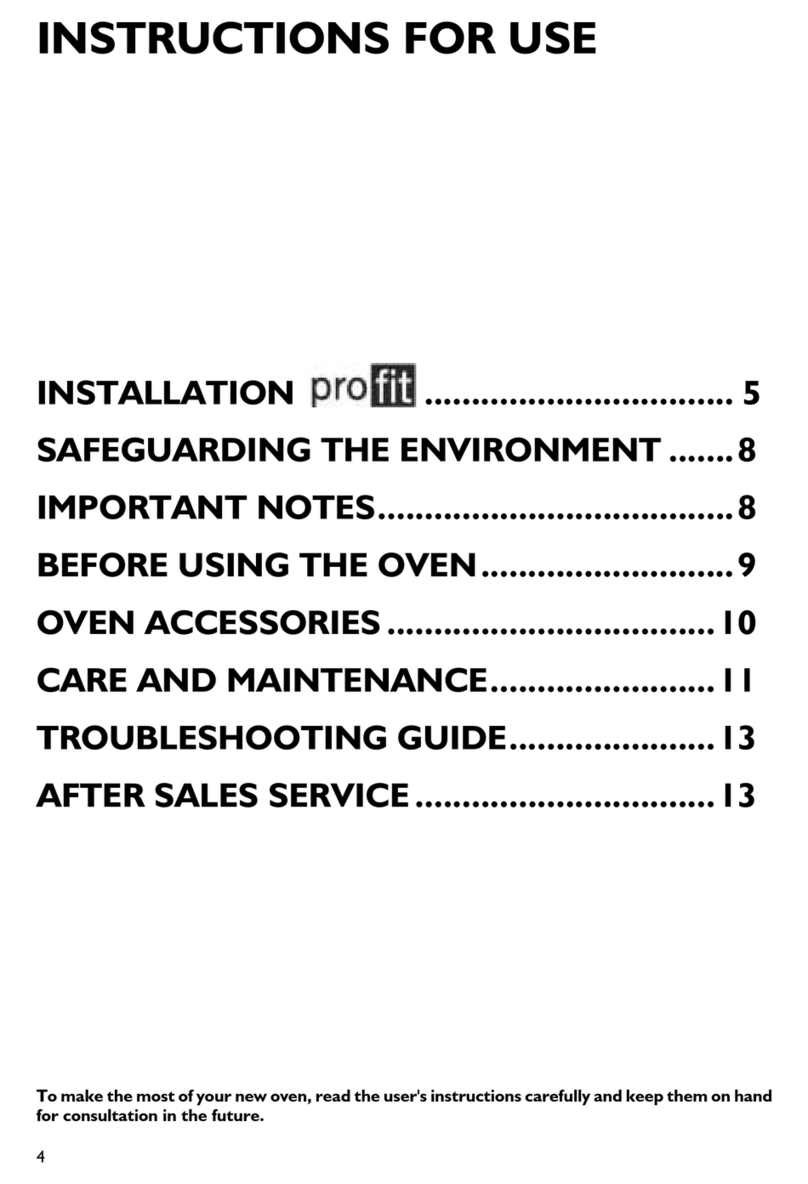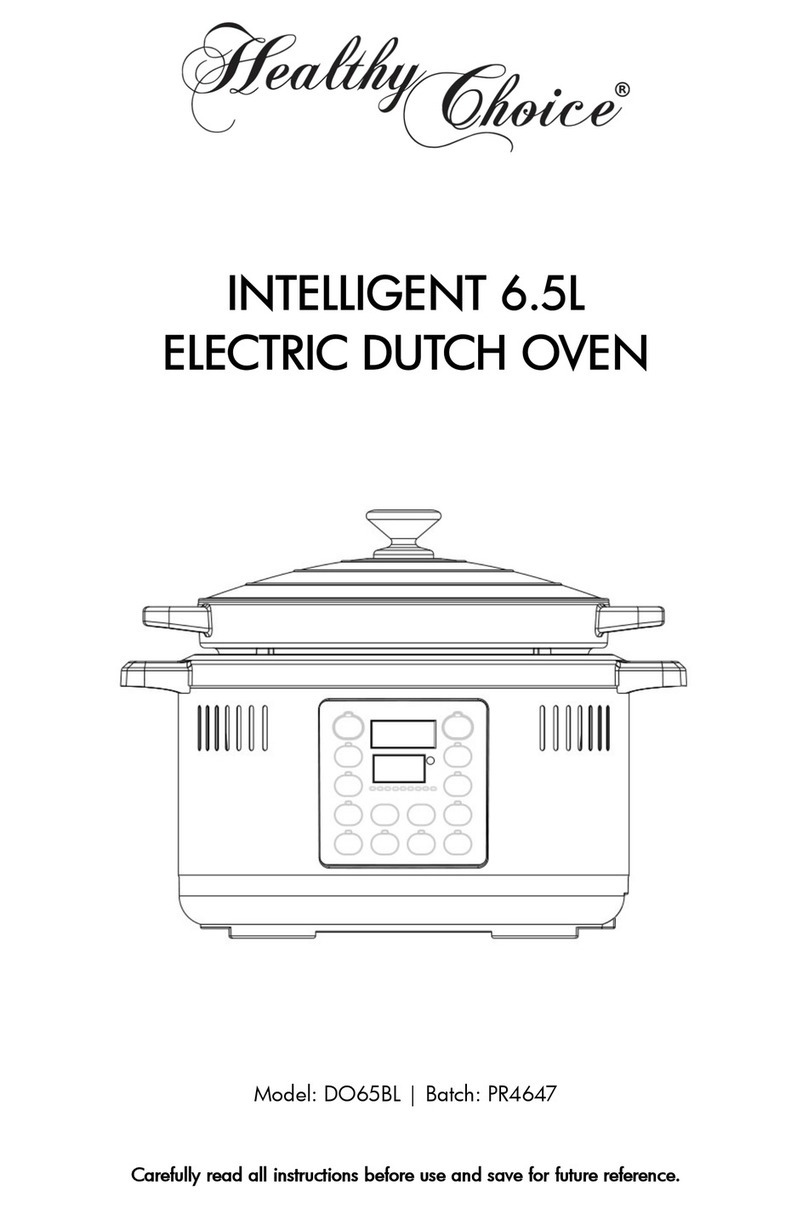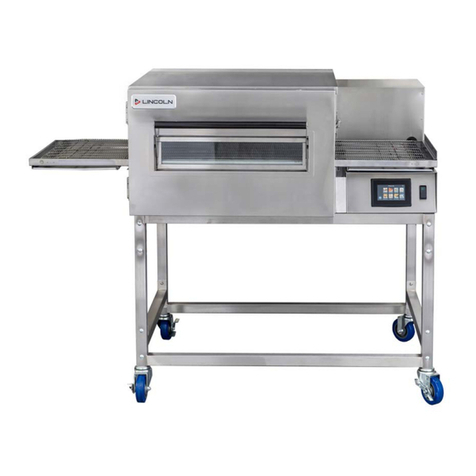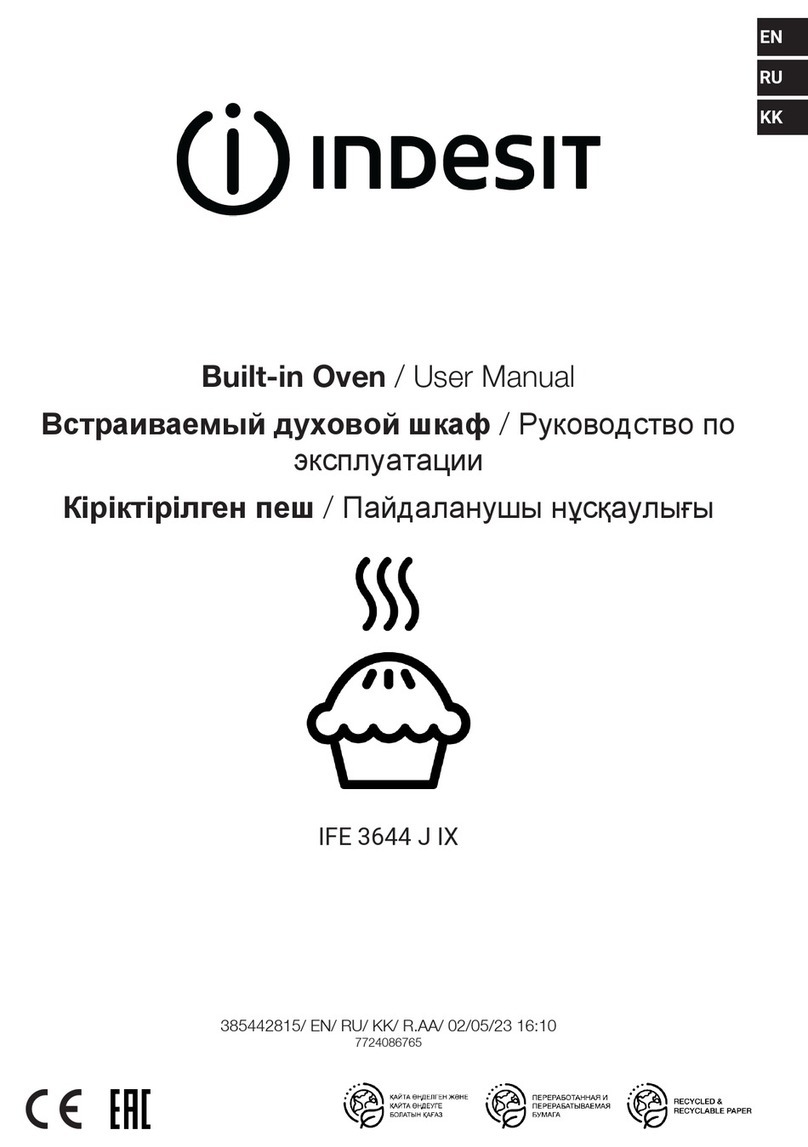Fontana Forni 8070-1PRO User manual

Hybrid Oven
User’s Manual
2
Quick Start Guide
3-9 User’s Manual
10-11 Saputo Stone Info
12-13 Warranty and Service Info

2
Quick Start Guide
Using a Hybrid / Dual Fuel Kit with your Fontana Oven
Switching from Gas to Wood:
1. Place Burner Cover: Take the stainless steel rectangular plate with a laser-etched 'F.' Place it
over the burner between the two brackets to shield it.
2. Cover Burner: This blocks any ashes from falling onto the burner.
3. Use Wood Holder: Positioned on the right-hand side of the cooking chamber. Follow regular
woodfired oven steps.
Switching Back to Gas:
1. Remove Wood Holder & Ashes: Clean the wood holder and ashes.
2. Remove Burner Cover: Ready to cook with gas again.
Starting Your Fontana Oven for the First Time:
For Napoli Ovens:
1. Connect Propane: Hook up the propane, hose, and regulator assembly to a 20-pound tank.
2. Check for Gas Escape: Listen for any gas escaping when you turn the valve on.
3. Ignite Oven: For Napoli - turn the gas knob to the lightning bolt. Press the gas knob in while
simultaneously pressing the igniter button. You should hear gas flow and see a spark which
will ignite the flame on the burner.
4. After ignition, you must continue to hold the gas knob in for a minimum of 30 seconds. This
ensures the thermocouple has been heated properly.
For Firenze or Roma Ovens:
1. Connect Propane: Hook up the propane, hose, and regulator assembly to a 20-pound tank.
2. Light Pilot Light:
a. Turn the gas knob to the lightning bolt.
b. Press and hold the knob for 1.5 to 2 minutes to flood the system with propane. (You
should feel it pressing closer to the oven)
c. Press the igniter button to light the pilot light. You will hear it click and can press it
any time after 60 seconds to see if it is good to go.
d. Continue holding the gas knob for 15 seconds so the thermocouple heats up.
e. Release the knob, then turn it to the flame setting to light the burner.
f. Repeat this process if the oven has been sitting for more than 24 hours.

3
Safety
Your new oven is a safe, convenient appliance when
assembled and used properly. As with all gas-fired products,
however, certain safeguards must be observed. Failure to
follow these safeguards may result in serious injury or
damage. If you have questions concerning assembly or
operation, contact our support team. This appliance is not
intended for commercial use.
CAUTION
FOR OUTDOOR USE ONLY.
IF STORED INDOORS, DETACH AND LEAVE
CYLINDER OUTDOORS.
THIS APPLIANCE MUST NOT BE OPERATED
UNATTENDED.
SPECIAL CARE MUST BE TAKEN TO KEEP
CHILDREN AND PETS AWAY FROM THE
APPLIANCE AT ALL TIMES.
THIS APPLIANCE WILL BE HOT DURING AND
AFTER USE. USE INSULATED OVEN MITTS OR
GLOVES FOR PROTECTION FROM HOT SURFACES.
DO NOT MOVE THE APPLIANCE WHEN IN USE.
ALLOW THE APPLIANCE TO COOL TO 115°F (45°C)
BEFORE MOVING OR STORING.
THIS APPLIANCE IS NOT INTENDED FOR AND
SHOULD NEVER BE USED AS A HEATER.
Use caution when handling or transporting this product.
Metal edges can be hazardous. Use appropriate gloves
when lifting or handling. Before lifting, remove any side
shelves, grids and grates.
ELECTRICAL CAUTION
1. If any accessory is used on this appliance that requires
an external electrical power source, the accessory
when installed must be electrically grounded in
accordance with local codes. In the absence of local
codes, the following standards apply:
(U.S.A.) ANSI/NFPA No. 70-Latest Edition
and
(Canada) CSA C22.1 Canadian Electrical Code
2. Do not cut or remove the grounding prong from the
plug.
3. Keep the electrical supply cord and fuel supply hose
away from any heated surface.
PROPOSITION 65 WARNING
Handling the brass material on this product exposes you to
lead, a chemical known to the state of California to cause
cancer, birth defects or other reproductive harm. WASH YOUR
HANDS AFTER HANDLING THIS PRODUCT.
WARNING
Fuels used in gas or oil-fired appliances, and the products of
combustion of such fuels, contain chemicals known to the
State of California to cause cancer, birth defects or other
reproductive harm. “This warning is issued pursuant to
California Health and Safety Code Sec. 25249.6”
Installation
1. In the USA, this appliance must be installed in
accordance with the local code and the relevant
national code:
ANSI Z223.1/NFPA 54 - Latest Edition National Fuel
Gas Code
ANSI/NFPA 58 - Latest Edition Storage and
Handling of Liquefied Petroleum Gases
2. In Canada, this appliance must be installed in
accordance with the local code and the relevant CSA
standards:
CSA-B149.1 Natural Gas and Propane installation
Code
CSA-B149.2 Propane Storage and Handling
3. The appliance must be located away from both
noncombustible and combustible surfaces by at least
1” (2.5cm) from each side, and 1” from the rear. If legs
are not installed, the appliance must be placed on
a non-combustible surface only.
4. DO NOT operate this appliance under any overhead
roof construction or foliage.
5. This appliance is for OUTDOOR USE ONLY, do not
operate in garage, shed, balcony or other such
enclosed areas.
6. DO NOT restrict the flow of air to the appliance.
7. Keep the area surrounding the appliance free of
combustible materials, gasoline, and all flammable
liquids and vapors.
8. This appliance is NOT intended to be installed in, or
on, recreational vehicles and/or boats.
9. Keep the ventilation opening(s) of the cylinder
enclosure free and clear from debris.
LP GAS CYLINDER PLACEMENT
The instructions below apply to LP models only. LP gas
cylinders must be installed in safety according to local
disposition. Always keep the cylinder in vertical position and
do not store a spare cylinder under or near this appliance.
Provide for retention means suitable for the size of the
cylinders.
NATURAL GAS INSTALLATIONS
Your new gas oven comes from the factory configured for use
with LP gas. The unit can be converted to natural gas by
using a natural gas conversion kit – available as an optional
upgrade. Please contact your dealer if you would like to order
a conversion kit.

4
LP Gas Cylinder
QCC®-1 QUICK CLOSING COUPLING
All models are designed to be used with an LP gas cylinder
equipped with the QCC®-1 Quick Closing Coupling system.
The QCC®-1 system incorporates safety features required by
the American National Standards Institute (ANSI) and the
Canadian Standards Steering Committee.
Gas will not flow until a positive connection has been
made.
A thermal element will shut off the flow of gas
between 240° and 300° F.
When activated, a Flow Limiting Device will limit the
flow of gas to 10 cubic feet / hour.
The LP Gas Cylinder is not included with the Gas Oven. Be
sure to purchase one with the QCC® valve. This valve is
recognized by the external threads on the inlet port of the
valve. QCC® equipped cylinders are available from your gas
smoker dealer.
NOTE: Any attempt to connect the regulator, by use of
adapters or any other means, to any other valve could
result in damage, fire or injury and may negate the
important safety features in the QCC®-1 system.
SPECIFICATION
1. All LP gas cylinders used with this appliance must be
constructed and marked in accordance with the
Specifications for LP Gas Cylinders of the U.S.
Department of Transportation (D.O.T.) or the National
Standard of Canada, CAN/CSA-B339, Cylinders,
Spheres and Tubes for Transportation of Dangerous
Goods; and Commission, as applicable.
2. The LP gas cylinder used for this appliance must not
have a capacity exceeding 20 lb. (9 kg).
• Approximately 18” (46cm) high and 12” (31cm)
3. All LP gas cylinders used with this appliance should
be inspected at every filling and re-qualified by a
licensed service outlet at the expiry date (10 years), in
accordance with the DOT (USA) and Canadian
Transport Commission (Canada) codes for LP Gas
Cylinders.
4. All LP gas cylinders used with this appliance must be
provided with a shutoff valve terminating in a
cylinder valve outlet No. 510, specified in the Standard
for Compressed Gas Cylinder Valve Outlet and Inlet
Connection (USA) ANSI/CGA-V-1-1977 (Canada) CSA
B96.
5. The cylinder supply system must be arranged for
vapor withdrawal.
6. The cylinder must include a collar to protect the valve
if the propane capacity is more than 2.2 lb (1 kg).
7. The cylinder must be installed as per assembly
instructions.
8. Never fill the cylinder beyond 80% full.
9. The cylinder valve must include a safety relief device
having direct communication with the vapor space
of the cylinder.
HANDLING
The LP Gas Cylinder is not included with the appliance. Be
sure to purchase one with the QCC® valve. This valve is
recognized by the external threads on the inlet port of the
valve.
A filled LP gas cylinder is under very high pressure. Always
handle carefully and transport in the upright position. Protect
the valve from accidental damage.
If the cylinder is tipped after it is connected to the regulator,
shut off the gas, disconnect the regulator and have it
checked before using it again.
STORAGE
Do not store any LP gas cylinders under or near the oven.
Store the LP gas cylinder outdoors in a well-ventilated place.
Do not store the LP gas cylinder in direct sunlight, near a
source of heat or combustion.
If you intend to store the appliance indoors, disconnect and
remove the LP gas cylinder first. Disconnected cylinders
must have a dust cap installed and must not be stored in a
building, garage, or any enclosed area.
When the LP gas cylinder is connected to the gas appliance,
the gas appliance and LP gas cylinder must be stored
outside in a well-ventilated place.
Keep out of the reach of children.
OPERATION
Never connect your gas oven to an LP gas cylinder without
the pressure regulator and hose assembly provided, and
NEVER TO AN UNREGULATED LP GAS SUPPLY.
Always leak test the LP gas cylinder to regulator connection
when connecting the LP gas cylinder to the appliance. See
“Leak Testing.” (page 5)
Do not operate if the smell of LP gas is present. Extinguish all
flames and determine source of LP gas before proceeding.
Do not ignite the appliance until the LP gas leak has been
found and sealed.
Always shut off LP gas cylinder valve when the appliance is
not in use.
If the precautions listed on this page are not taken, a fire
causing death or serious injury may occur.

5
OPD Equipped Cylinder
OVERFILL PREVENTION DEVICE
1. The standard for outdoor gas appliances, ANSI Z21.58/
CAN/CGA-1.6, requires that appliances be used with
cylinders equipped with an Overfill Prevention Device
(OPD).
2. The OPD is designed to reduce the potential for the
overfilling of propane cylinders, thus reducing the
possibility of relief valve discharges of raw propane.
The OPD causes a slower purge/fill operation.
Some consumers have been advised by filling
stations that these cylinders are “defective.” This is
not a defect. Some propane filling stations may not
be aware of this device and its effect on the purge/fill
operation.
3. New OPDs coming onto the market have technology
that allows for much greater BTU outputs which will
decrease the amount of time it takes to purge a
cylinder.
IDENTIFICATION
To identify these cylinders, the OPD handwheel has been
standardized to the shape shown.
Hose & Regulator
All models are equipped with a hose and regulator with a
QCC®-1 Quick Closing Coupling.
The QCC® coupling contains a magnetic Flow Limiting
Device which will limit the flow of gas should there be a leak
between the regulator and the appliance valve. This device
will activate if the cylinder valve is opened while the
appliance valves are open. Be sure the appliance valves are
off before the cylinder valve is opened to prevent
accidental activation.
The QCC® coupling incorporates a heat sensitive hand wheel
that will cause the back check module in the QCC® cylinder
valve to close when exposed to temperatures between 240°
and 300°F. Should this occur, do not attempt to reconnect
the hand wheel. Remove hose/regulator assembly and
replace with a new one.
The pressure regulator is set at 11 inches WC (water column)
and is for use with LP gas only. The hose and hose couplings
comply with CGA Standard CAN 1.83. No modifications or
substitutions should be attempted.
Protect the hose from dripping grease and keep the fuel
supply hose away from any heated surface(s), including the
base casting of the barbecue.
Inspect the seal in the QCC® cylinder valve when replacing
the LP gas cylinder or once per year whichever is more
frequent. Replace the seal if there is any indication of cracks,
creases, or abrasion.
Inspect and clean the hose before each use. If the hose is
cracked, cut, abraded, or damaged in any way, the hose must
be replaced prior to the appliance being put into operation.
For repair or replacement of the hose/regulator assembly
(see page "component list"), contact our support team.
CONNECTION
1. Be sure cylinder valve and appliance valves are “OFF.”
2. Center the nipple in the cylinder valve and hold in
place. Using your other hand, turn the hand wheel
clockwise until there is a positive stop. Do not use
tools. Hand tighten only. When making the
connection, hold the regulator parallel to the cylinder
valve, so as not to cross thread the connection.
3. Leak test connections. See “Leak Testing.” (page 6)
4. Refer to lighting instructions. To avoid activating the
Flow Limiting Device when lighting, open cylinder
valve slowly with the appliance valves off. If the Flow
Limiting Device is accidentally activated, turn off
cylinder valve and appliance valves, wait 10 seconds
to allow the device to reset, open cylinder valve
slowly, then open the appliance valve.
DISCONNECTION
Always close LP cylinder valve and remove coupling nut
before moving cylinder from specified operation position.

6
Leak Testing
All factory-made connections have been rigorously tested for
gas leaks. However, shipping and handling may have
loosened a gas fitting.
SAFETY PRECAUTIONS
Test all fittings for leaks before using your
appliance.
Test for leaks every time you connect a gas fitting.
Do not smoke at any time while testing.
Never test for leaks with a lit match or open flame.
Test for leaks outdoors.
Test LP cylinder valve for leaks each time the
cylinder is filled.
If a leak persists, contact your gas appliance dealer
for assistance. Do not attempt to operate
appliance if a leak is present.
LEAK TEST WITH AN LP CYLINDER
To test for leaks between the LP Cylinder and Gas Valve
1. Extinguish any open flame or cigarettes in the area.
2. Be sure that cylinder and appliance valves are “OFF.”
3. Connect LP gas cylinder. See “Hose and Regulator.”
4. Prepare a soap solution of one part water, one part
liquid detergent.
5. Brush the soap solution on each connection.
6. With a full gas cylinder, open cylinder slowly.
7. A leak is identified by a flow of bubbles from the area
of the leak.
8. If a leak is detected, close the gas cylinder “shut-off”
valve, tighten the connection and retest.
LEAK TESTING ON NATURAL GAS
To test for leaks between the Natural Gas Supply and Gas
Valve
1. Extinguish any open flame or cigarettes in the area.
2. Be sure gas supply and appliance valves are “OFF.”
3. Prepare a soap solution of one part water, one part
liquid detergent.
4. Brush the soap solution on each connection.
5. Slowly open the natural gas supply valve.
6. A leak is identified by a flow of bubbles from the area
of the leak.
7. If a leak is detected, close the natural gas supply
valve, tighten the connection and retest.
If the Gas Supply System is pressure tested
1. The appliance and its individual shutoff valve must
be disconnected from the gas supply piping system
during any pressure testing of that system at test
pressures more than 1⁄2 psi (3.5 kPa).
2. The appliance must be isolated from the gas supply
piping system by closing its individual manual
shutoff valve during any pressure testing of the gas
supply piping system at test pressures equal to or
less than 1⁄2 psi (3.5 kPa).

7
Lighting
BASIC GAS OVEN COMPONENTS
A - Ignitor button D - Oven
B - Gas knob E - Chimney
C - Door F - Chamber thermometer
LIGHTING INSTRUCTIONS
1. The appliance must be assembled as per the
assembly instructions.
2. Ensure the gas supply is properly connected to the
appliance. LP installations see: “Hose and Regulator.”
(page 4) NG installations see: “Natural Gas Conversion
Kit” manual.
3. Ensure there are no gas leaks in the gas supply
system. See: “Leak Testing.” (page 6)
4. Ensure that Burner ignition wires are connected.
5. WARNING: Always open door before lighting.
6. Set control knobs to “OFF” and turn on the gas
supply.
LIGHTING THE BURNER
1. Open door (C) and leave open until lit.
2. Check that the battery has been installed in the
electronic ignitor.
3. Push, hold down and turn burner control knob (B) to
“HIGH” or "pilot flame" and push ignitor button (A)
4. Burner should ignite within 5 seconds; close gas
immediately if ignition does not occur in this
timeframe.
CAUTION - Check your burner’s flame after lighting. All
burner holes should show upper to 2.5cm / 1” flame on
“HIGH.” The flames should be mostly blue and without
lifting.
If the burner still does not ignite:
Push and turn control knob to “OFF.” Wait 5 minutes then try
again with control knob set at “MEDIUM.”
If that doesn’t work, see “Troubleshooting” on page 8. If the
problem persists, do not attempt to operate the appliance;
contact our support team.
Operation
WARNING: The use of alcohol, prescription or non-
prescription drugs may impair the consumer’s ability to
properly assemble or safely operate the appliance.
TIPPING HAZARD:
Place the gas cylinder in the appropriate secure and fixed
position to avoid overturns and accidents.
First Time Use: Before cooking with your gas appliance for
the first time, burn it off (see page 7) to rid it of any odors or
foreign matter in the following manner:
Preheating: Preheat the appliance on MEDIUM/HIGH with
the door closed for ten minutes. Reduce heat as appropriate
for your application.
Door Position: The position of the door during operation is a
matter of personal preference, but the appliance cooks faster,
uses less fuel, and controls the temperature best with the
door closed. A closed door also imparts a smokier flavor, and
is essential for smoking and convection cooking.
Shutdown:
1. Turn off cylinder valve/main gas supply.
2. Turn control knobs to “OFF.”
E
D
C
F
A
B

8
Maintenance
REGULAR MAINTENANCE
The following components should be inspected and cleaned
(as necessary) before every usage of your gas appliance to
ensure optimal performance, safety and efficiency.
General Cleaning
Perform a Burn-Off (see below). When appliance is cool, clean
the interior of the appliance if necessary by scraping the
bottom of the cooking plane and vacuuming.
Burn-Off
Ignite the burners as per “Lighting” (page 6). Operate gas
appliance on HIGH with door closed for 10 min. or until
smoking stops. Turn the gas source off then turn control
knobs to OFF.
ANNUAL MAINTENANCE
The following components should be inspected and cleaned
at least once a year or after any period of storage over 30 days
to ensure optimal performance, safety and efficiency.
Burner
Remove burner and inspect for cracks and deterioration.
Clean venturi tubes using a pipe cleaner to eliminate any
blockages. See “Venturi Tubes.” While the burner is removed,
clean the interior of appliance by scraping the bottom of the
cooking plane and vacuuming.
Hose
Inspect and replace if necessary. For propane see “Hose and
Regulator.” (Page 4)
Orifice
Inspect the orifice to make sure it is not blocked, misaligned,
or loose.
Stainless Steel
Wash with soap and water. Use stainless steel cleaner to
polish and remove stains or marks. Extreme heat can cause
the color to change. This discoloration is not considered a
manufacturing defect.
Replacement Parts
If a problem is found with the regulator, hose, burner, or
control valves, do not attempt repair. See your dealer,
approved service center, or contact the factory for repairs or
replacement parts. To ensure optimum performance, use
only original replacement parts.
Leak Test
When reconnecting that appliance to a gas supply, be sure to
check for leaks. See “Leak Testing.” (Page 5)
Venturi Tube
Always keep venturi tube clean. Blockages in the venturi tube
caused by spiders, insects and nests can cause a flashback
fire. In fact, although the gas burner may still light, the
backed up gas can ignite and cause a fire or small flare.
If a flashback fire occurs, turn off gas at the source
immediately.
Inspect and clean the venturi tubes if any of the following
symptoms occur:
You smell gas.
Your appliance does not reach temperature.
Your appliance heats unevenly.
The burners make popping noises.
INSPECTING & CLEANING VENTURI
TUBES
1. Turn off gas by closing the propane cylinder valve.
2. When appliance is cool, clean the venturi tube with a
pipe cleaner.
3. The burner is accessible only after removing the box
underneath the oven.

9
Troubleshooting
Before calling for service, please perform the following simple checks:
Ensure there is fuel supplied to the oven.
Is your propane cylinder empty?
Have you recently refilled the propane cylinder?
If so, is the connection tight? Have you opened the valve on the propane cylinder?
If you’ve checked the above items, review the troubleshooting list below before calling for service.
Problem
Possible Cause
Corrective Action
Smell of Gas
SHUT OFF GAS SUPPLY IMMEDIATELY.
DO NOT USE THE APPLIANCE UNTIL THE
LEAK IS SEALED.
Leak detected at
cylinder, regulator or
other connection.
1.
Regulator fitting loose
2. Gas leak in hose/regulator valves
1.
Tighten fitting and Leak Test (page
5)
2. Contact authorized service center.
Flames
beneath
control panel
Venturi tube blocked
Remove burner and clean vent
uri tube
– see page 7 for assistance.
Flickering
burner
flame
Or
Low temperatures on
High setting
Excess flow safety device has been activated in
connection between cylinder and oven
Turn LP cylinder valve off, then t
urn all
burners to OFF position. Disconnect
the regulator from the cylinder. Wait
two minutes. Re-attach the
regulator to the cylinder. Open the
cylinder valve slowly. Wait one
minute. Light oven as normal.
Burner not lighting
1.
Out of LP Gas/Gas Supply Valve off
2. Ignitor issue
3. Excess flow safety device has been activated
4. Regulator is not fully connected to the cylinder
valve
5. A leak in the system causing the excess flow device
to activate
6. Venturi blocked or misaligned with valve orifice
7. Orifice blocked
8. Hose is twisted
9. Burner ports blocked
1.
Refill LP Gas Cylinder/
turn on main
gas supply valve
2. See “ignitor not working” below
3. Follow steps above for flickering
burner flame
4. Tighten the regulator hand wheel
5. Leak test connections to
determine loose fitting. Tighten
fitting. Leak test system.
6. Clean venturi tube (page 5)
7. Clean orifice with a pin or fine wire
Do not drill orifices.
8. Straighten hose
9. Remove burner & clean with a
toothbrush
Ignitor not working
1.
Ignitor battery is dead
2. Ignitor wire(s) not connected
3. Electrode misaligned on burner
4. Ignitor malfunction
1.
Replace battery
2. Ensure burner electrode wires are
connected
3. Realign electrode and clear any
surrounding debris from area
4. Contact your dealer for a
replacement ignitor
Decreasing heat,
popping sound
1.
Out of LP Gas
2. Venturi blocked
Hot spots on cooking
surface
1.
Venturi blocked
2. Burner ports partially blocked by debris
1.
Remove burner, clean venturi
–
see page 7 for assistance.
2. Remove burner & clean with a
toothbrush
Regulator
making
humming noise
Cylinder valve opened too quickly
Open cylinder valve slowly
Yellow Flame
1.
Some yellow flame is normal. If it is excessive, the
venturi may be blocked
2. Burner ports partially blocked by debris
1.
Clean venturi
-
see page 7 for
assistance
2. Remove burner & clean with a
toothbrush
If troubleshooting fails to solve any of these or any other issues, please contact your
dealer or reach out to our
support team
–
see information on page 13.

10
Saputo Stone Information
Saputo Stones are exclusively available to you as an optional
upgrade with the purchase of this oven. They have the
unique ability to cook pizza using the true Neapolitan
method at 806°F – 896°F (430°C – 480° C) in the Fontana
without burning the bottom of the dough.
Saputo stones are handmade by Italian artisans in Naples
using methods and techniques that have been used for
generations. Using the local clay, each stone begins its life by
being hand formed into wooden molds. The clay forms are
then air dried allowing the clay to release a specific amount
of moisture before firing. Once dried, the forms are carefully
loaded into a wood fired kiln. The kiln is fired to a specific
temperature, and the artisans stay with the kiln for several
days to maintain the kiln temperature. Once the firing
process is complete, the stones are removed and ready for
use.
Maintenance
The Saputo stones are made using a material & process that
produces a softer stone, as result, they are quite fragile. Treat
them with care when moving them in and out of the oven.
To clean Saputo stones, we recommend using a brass bristled
brush, while the stones are still warm, to gently remove any
excess food particles. It is safe to periodically clean the stones,
while they are cold, with a slightly damp cloth to remove any
food debris or residue. Make sure the stones are completely
dry before firing them up to temperature again. Any
residual moisture absorbed into the stone that is quickly
heated could result in thermal shock that could potentially
crack the stone. Never use any cleaning solutions or liquids
to clean your stones.
Troubleshooting
Because these stones are handmade, there is the rare
instance you may run into a slight unevenness in your
cooking floor surface. If one stone is lower than another, we
recommend placing a small amount of sand underneath the
lower stone to help raise that stone and even out the cooking
floor surface. This is common practice with traditional
ceramic masonry ovens that works well in this scenario as
well.
Unfortunately, we cannot replace stones that have small
chips in them. Because these stones are handmade, air
dried & then kiln dried, it quite often results in
imperfections and chipping along the edges. Chipping
does not alter the performance of the stone or oven,
therefore is not considered a defect. If a customer finds
chipping on the stone bothersome, we recommend
rotating the stone when possible, to achieve the
smoothest surface or touching up the edge with
sandpaper.
Replacing Stones
When swapping out Standard stones for Saputo Stones,
the first Standard stone can be removed by using a flat
head screwdriver to pry up the first stone. The subsequent
Standard stones can be removed by hand. When placing
the Saputo stones in your oven, place each stone in the
oven with the smooth side facing up. It is important to
make sure you have the long side of each stone
oriented as is depicted in your oven’s diagram. If the
stones are not oriented as shown, the stones will not fit
inside the oven.
Saputo Stone Layout
Back
Front of Napoli
LONG
SIDE
LONG
SIDE
Back
Front of Roma
LONG
SIDE
LONG
SIDE
LONG
SIDE
Back
Front of
Firenze
LONG
SIDE
LONG
SIDE
LONG
SIDE
LONG
SIDE

11
Standard Stone Layout
Back
Back
Back
Front of
Firenze
Front of
Roma
Front of
Napoli

12
Warranty
Product Warranty Information
At Fontana Forni, we are committed to providing our customers with high-quality products designed to enhance your
cooking experience. We take pride in the quality and durability of our pizza ovens. To assure your satisfaction and peace of
mind, we offer the following warranty coverage:
1. Two-Year Manufacturer's Warranty:
We provide a comprehensive two-year warranty against manufacturer defects for all our products. If you encounter any issues
related to manufacturing defects during this period, please contact us immediately using our contact page or by phone. Our
dedicated team will work diligently to resolve any such issues promptly.
2. Four-Year Warranty on the Dome:
Specifically for the dome of the cooking chamber, we offer a four-year warranty. This warranty demonstrates our confidence in
the durability and performance of our ovens. In case you experience any dome-related concerns within this four-year period,
kindly get in touch with us for assistance.
Stones Disclaimer:
Due to the delicate nature of the stones used in our ovens, we regretfully cannot offer a warranty on the stones themselves.
However, if your oven arrives with any damaged stones, please notify us immediately, and we will address the matter
promptly.
Exclusions from Warranty Coverage:
It's important to note that our warranty does not cover the following items:
Damage resulting from shipment or transportation issues that were not noted in the bill at the time of receiving the
oven.
Damage arising from negligent unpacking of the oven.
Damage due to improper assembly or installation of the oven.
Damage resulting from heating the oven beyond its maximum temperature rating.
Damage resulting from the use of combustible materials other than wood for lighting fires in the oven.
Damage or corrosion caused by exposure to the elements and/or chemicals.
Damage that leads to a broken or stuck chamber thermometer.
At Fontana Forni, we are committed to your satisfaction and the lasting performance of our products. Our warranty coverage
ensures that we stand by our quality and craftsmanship. If you have any questions or require assistance related to warranty
claims, please do not hesitate to contact us. We are here to serve you.

13
Contacting Customer Service
If service is required, call Fontana Forni USA at (877) 842-9822
or email support@fontanaovens.com
Locate the serial number and model number on the rating plate at the oven's rear.
In the event of a claim, it is essential to have the following information readily available. We
recommend recording the information for
future reference:
Order number:
___________________________
Model name/number:
___________________________
Serial number:
___________________________
Date of purchase:
___________________________
Service Hours: Our customer service operates
from 8 am to 5 pm, Monday to Friday, Eastern
Standard Time (EST).
Support Outside Operating Hours: For urgent matters outside regular hours, leave a detailed
voicemail or mark emails as urgent. We'll address critical issues promptly.
Expected Response Time: Expect an email response or callback within 24 hours during our service
hours.
Attach Visuals for Faster Resolution: When emailing, attach relevant photos or videos to expedite
troubleshooting.
Online Resources and FAQs: Check our online resources before reaching out for quick answers.
_______________________________________________________________________
When servicing involves component installation, use authorized parts for warranty coverage.

DQD 507 Rev. 2019-04-30 © 2018 CSA Group. All rights reserved. Page 1
Certificate of Compliance
Certificate:
80132492
Master Contract:
303020
Project:
80132492
Date Issued:
2023-02-06
Issued To:
FONTANA FORNI S.R.L.
Via G. Di Vittorio,6
San Lorenzo in Campo, Pesaro e Urbino, 61047
Italy
Attention: Marco Fontana
The products listed below are eligible to bear the CSA Mark shown with
adjacent indicators 'C' and 'US' for Canada and US or with adjacent
indicator 'US' for US only or without either indicator for Canada only.
Issued by:
Stefano Vaglica
Stefano Vaglica
PRODUCTS
CLASS - C271106 - DOMESTIC GAS COOKING APPLIANCES - Outdoor Specialty Cooking Gas
Appliances
CLASS - C271186 - DOMESTIC GAS COOKING APPLIANCES-Outdoor Specialty Cooking Gas
Appliances-Certified to U.S. Standards
Gas Pizza Oven
For Use on Natural or Propane Gases
Trade Name: Fontana Forni
Model:8070-1PRO / 8070-2PRO
Model:6070-1PRO / 6070-2PRO
Model:6050-1PRO / 6050-2PRO

Certificate: 80132492
Project: 80132492
Master Contract: 303020
Date Issued: 2022-02-06
DQD 507 Rev. 2019-04-30 © 2018 CSA Group. All rights reserved. Page 2
Trade Name: Bull
Model:8070-3PRO
Model:6070-3PRO
Model:6050-3PRO
APPLICABLE REQUIREMENTS
ANSI Z21.89-2017/CSA 1.18-2017 Outdoor Cooking Specialty Gas Appliances
Notes:
Products certified under Class C271106, C271186 have been certified under CSA’s
ISO/IEC 17065 accreditation with the American National Standards Institute (ANSI).
www.ansi.org

DQD 507 Rev. 2019-04-30 © 2018 CSA Group. All rights reserved. Page 1
Supplement to Certificate of Compliance
Certificate: 80132492
Master Contract: 303020
The products listed, including the latest revision described below,
are eligible to be marked in accordance with the referenced Certificate.
Product Certification History
Project
Date
Description
80132492
2023-02-06
Original Certification for Gas Pizza Oven Models 8070-1PRO Fontana
Brand / 8070-2PRO Fontana Brand / 8070-3PRO Bull Brand - 6070-1PRO
Fontana Brand / 6070-2PRO Fontana Brand / 6070-3PRO Bull Brand -
6050-1PRO Fontana Brand / 6050-2PRO Fontana Brand / 6050-3PRO Bull
Brand according to ANSI Z21.89-2017/CSA 1.18 –2017 Outdoor Cooking
Specialty Gas Appliances
This manual suits for next models
5
Table of contents
Other Fontana Forni Oven manuals

Fontana Forni
Fontana Forni MARGHERITA 60X60 User manual

Fontana Forni
Fontana Forni BELLAGIO Operating instructions

Fontana Forni
Fontana Forni MAESTRO 60 User manual

Fontana Forni
Fontana Forni GUSTO User manual
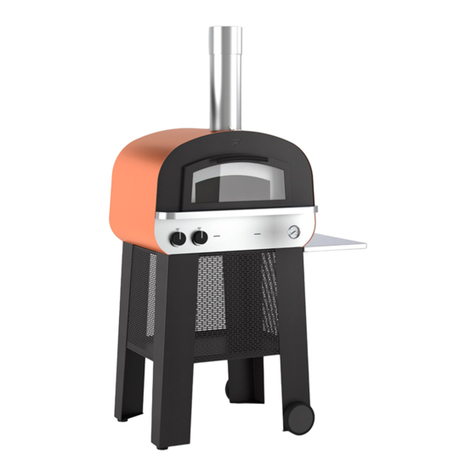
Fontana Forni
Fontana Forni PIERO User manual

Fontana Forni
Fontana Forni PIZZA&CUCINA DOPPIO Operating instructions
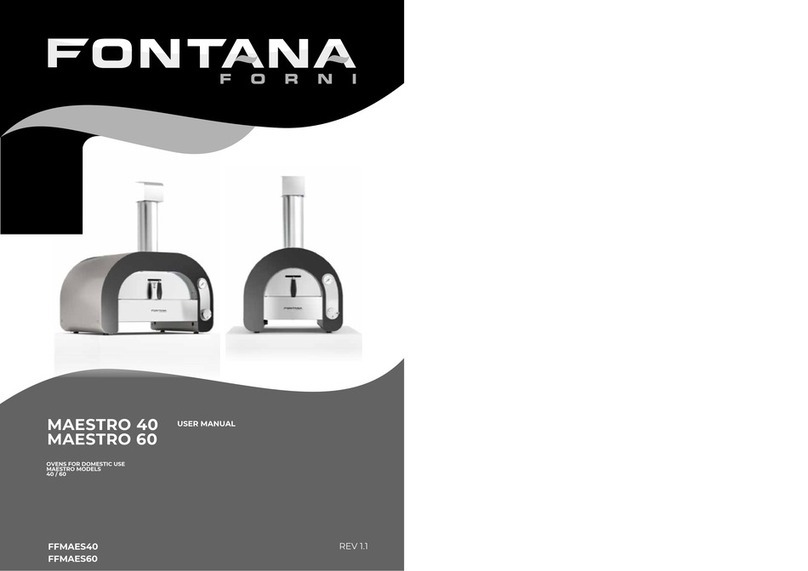
Fontana Forni
Fontana Forni MAESTRO 40 User manual

Fontana Forni
Fontana Forni FORNO ITALIA Series Setup guide

